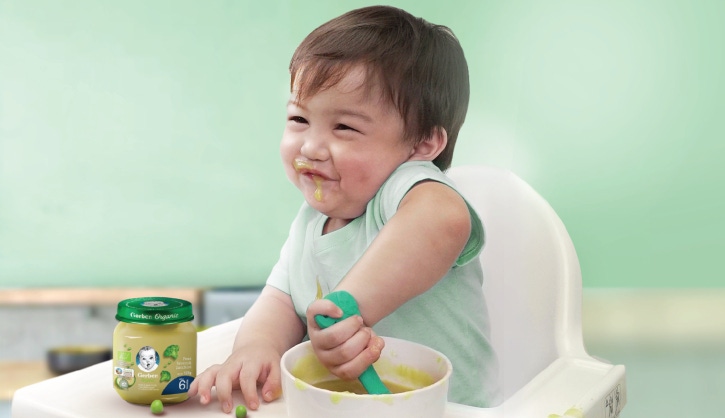Why do we give solid food?
Children need adequate energy intake and a diet that provides the nutrients for growth and cognitive development. As we start them on solid food, we also establish an optimal diet for their lifelong growth & well-being.
The 2018 Feeding Infant and Toddler Study (FITS) assessed the food consumption patterns of Filipino children. It was found that children aged 6 to 35 months consumed mainly rice and sugary snacks while nutrient dense-food items such as fruits and vegetables played little role in their diet. Sweets was also the third most consumed food group among 6 to 11 months and the second most consumed food by toddlers 1 to 3 years old (next to rice). The FITS Study also found that Filipino children have inadequate intakes for minerals such as calcium and zinc, as well as many vitamins such as vitamin C, folate, riboflavin, and vitamin B.
At 6 to 8 months, your little one is also at risk for iron deficiency. This is because as they get older, the natural iron stores they had since birth gets depleted. Hence, it is important to have iron sources in their diet.
For these reasons, establishing healthy feeding choices for your little one is important.
The right time for solids
Solid food is typically introduced by the time your little one is 6 months old, a period when important milestones for feeding and swallowing solid food start to develop. At this stage, he can sit upright with support and has good head control. It is also at this time when your child will start grabbing small objects with his fingers, transfer them from one hand to another, and even put things in his mouth. He can also open his mouth, move around food in their own mouth, and swallow. As your child gets older, you will notice that your child’s ability to chew becomes more coordinated, thus allowing him to transition to a more textured food.
It’s an exciting period but make sure to give plenty of time and patience.

What kind of food do I give?
You can start by giving single ingredient food one at a time. For example, you may give 1 to 2 teaspoons of pureed fruit or vegetable, iron-fortified cereal, or baby food (not a mixed variety). Wait for about three days before introducing a new kind of food item. This helps you determine if your baby is sensitive to a particular food. Serve mixed fruit or veggie combos only after they have tried each of the food individually. If no reaction or sensitivity to food is observed, you may move to mixed vegetables, meat, and rice cereal.
Remember that symptoms may occur within minutes of eating a particular food or they may not appear for hours or even days. Some symptoms to watch out for include skin rash, diarrhea, or vomiting. If any of these symptoms occur, stop the new food and get in touch with your pediatrician.
At 6 to 8 months, you can give your little one solid food 2 to 3 times a day. Starting 9 to 24 months, you may give solid food 3 to 4 times a day plus 1 to 2 snacks.
You may also progress the texture of the food by giving it pureed at 6 to 8 months, mashed at 7 to 9 months, small chunks minced at 10 to 11 months, and bite-sized at 12 months.
It is no longer generally recommended to delay solid foods that might be possible food allergens. In fact, studies show that introducing these foods around 6 months or not did not lead to many babies developing allergies to food
Make sure you check with your pediatrician first to find out if your baby is ready to start solid foods, needs more iron in their diet, or should follow any specific instructions about food allergens.
Fruit and vegetable baby food
Once your baby has mastered single-grain infant cereals, they may be ready to add single fruit and vegetable baby foods. Pureed veggies and fruits add new flavors and textures to their world. Baby foods are just the right consistency for their practicing tongue movements, improves their ability to chew solid texture, and for advancing their eating skills. Available in many different varieties, baby foods also come in organic versions.
References:
1. Young B, et al. Complementary Feeding: Critical Considerations to Optimize Growth, Nutrition, and Feeding Behavior. Curr Pediatr Rep. 2013 Dec 1; 1(4): 247–256.
2. Denney L, Angeles-Agdeppa I, et al. Nutrient Intakes and Food Sources of Filipino Infants, Toddlers and Young Children are Inadequate: Findings from the National Nutrition Survey 2013. Nutrients 2018;10: 1730.
3. Scaglioni S, et al. Influence of parental attitudes in the development of children eating behaviour. Br J Nutr 2008;99 Suppl 1:S22-25.
4. Paroche MM, et al. How Infants and Young Children Learn About Food: A Systematic Review. Front Psychol. 2017; 8: 1046.
5. USDA Food Safety and Inspection Service resources page. Safe Minimum Internal Temperature Chart [Internet]. 2020 May 11 [cited 2020 Aug 31]. Available from: https://www.fsis.usda.gov/safetempchart.
6. Greeg FR, et al. Infant Methemoglobinemia: The Role of Dietary Nitrate in Food and Water. Pediatrics. 2005;116(3):784. Available from: https://pediatrics.aappublications.org/content/pediatrics/116/3/784.ful…










